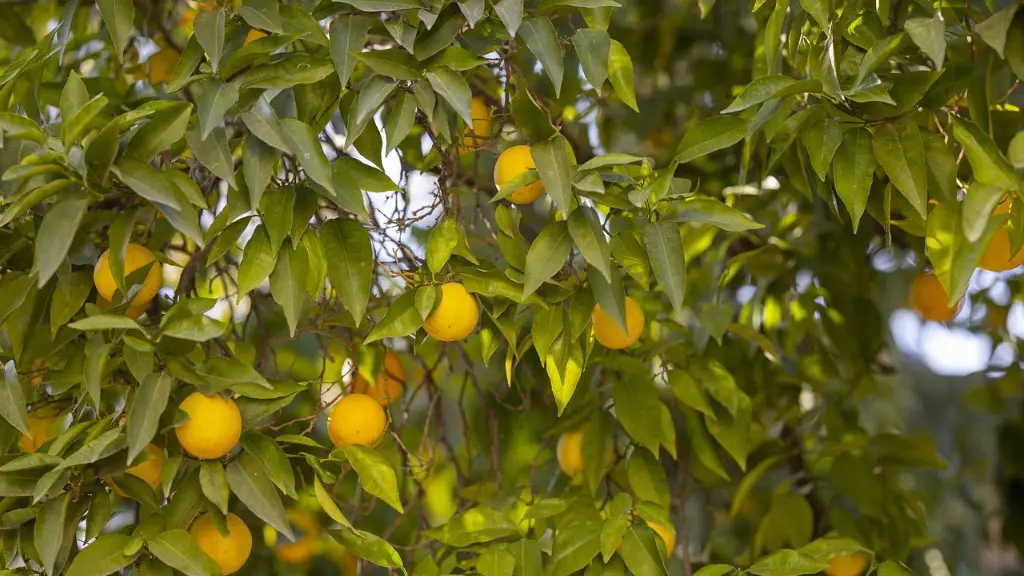Lemons are a symbol of refreshment, essential to the flavor of many of our favorite foods and drinks. But where do they come from? Most lemon trees are grown in a warm climate, such as California in the US. And, do lemon trees need sun to grow? The answer is a resounding YES. Sunlight is essential for citrus trees to produce juicy, colorful, vibrant fruits.
In order for a lemon tree to thrive, it requires at least 8-10 hours of direct sunlight each day. This helps the tree to produce the energy it needs to sustain healthy growth and fruit production. Shortening the tree’s sunlight hours may disrupt its growth cycle in many ways. For example, blossom and fruit growth may be hindered, and leaves may become susceptible to disease and pests.
In addition to adequate sunlight, lemon trees need a reliable source of water to encourage their growth. Overwatering can be just as damaging as underwatering. Lemon trees have a shallow root system and therefore require regular and well-timed watering. To determine if a lemon tree needs water, check to see if the soil is dry. If it is, water it well but make sure to avoid stagnant water in the root system.
Lemons also rely on temperature swings to encourage healthy growth. Temperatures that are too low or too high can cause the tree to produce too much or too little growth. Aim to maintain a consistent temperature range to promote healthy growth and prevent any major losses in quality. Frost and cold temperatures can damage the tree and its fruits.
In addition to sun, water, and temperature ranges, a balanced fertilizer is essential for a healthy lemon tree. Fertilize the tree with nitrogen-based fertilizers throughout the year, paying special attention to fruit production times. Doing so will help to increase the size and flavor of the fruits. Be sure to check the label of the fertilizer to ensure it is recommended specifically for citrus trees.
Caring for a lemon tree can be a rewarding experience due to the abundance of flavorful and nutrient-rich fruits it produces. Offering the tree sufficient sunlight, water, temperature and fertilizer are essential for nurturing strong and vibrant growth.
Soil Ph for Lemon Trees
The soil ph of a lemon tree is an important factor that helps the soil absorb nutrients from fertilizer. The ideal soil ph for lemon trees is between 6.0 and 7.0, which is slightly acidic to neutral. Soil with a ph lower than 6.0 becomes too acidic for lemon trees, preventing the absorption of essential nutrients.
To test the soil’s acidity, you can purchase an inexpensive soil ph test kit and follow the instructions, or you can bring a sample of your soil to a local garden center, university soil lab, or agriculture extension office to have it tested. Often times the location of your lemon tree will determine the soil’s acidity, as soil in certain regions are naturally more acidic than others.
If you have areas of the soil where the ph is higher or lower than what is recommended for lemon trees, you can modify this by applying sulfur and lime to the soil. Sulfur will lower the ph and lime will raise it. Be sure to test the soil again after amendments have been applied, so that the ph is in the optimal range for your lemon tree.
In addition to modifying the soil’s ph, you should also ensure that the soil is well aerated and has good drainage, as stagnant or waterlogged soil can suffer from root rot. If necessary, perform a soil test to ensure that the soil has adequate levels of key nutrients.
Frost Protection for Lemon Trees
Protecting lemon trees from frost and cold temperatures is necessary for producing a healthy harvest of flavorful fruits. Lemon trees are especially sensitive to cold temperatures, as a frost can cause the tree to drop blossoms, fruits, and leaves. For this reason, it’s important to keep the tree warm on cold winter nights if temperatures dip below freezing.
There are several ways to protect lemon trees from frost. One way is to build a low, perforated wall around the tree and use straw, wood chips, or other natural material to add insulation and reflect the sunlight back onto the tree. Additionally, you can use Christmas lights, water pipes, charcoal grills, and other forms of heating to warm the air around the tree.
In addition to insulating the air around the tree, you should also take steps to protect the soil. Direct heat from the sun during the day can help to warm the soil and protect the roots from cold temperatures during the night. You can also cover the soil with mulch or straw for insulation.
Wrap up the tree itself with a blanket or breathable, lightweight fabric to protect it from temperatures below freezing. The fabric should be breathable to allow the tree to keep as much warmth as possible. You can also position the tree close to south facing walls, buildings, or other surface to benefit from additional warmth.
Fertilizing Lemon Trees
Fertilization is important for the health of your lemon tree and its ability to produce vibrant fruits. The right kind of fertilizer will help to replenish nutrients in the soil and encourage healthy growth. Typically, citrus fertilizers have a higher percentage of nitrogen, which helps to promote foliage growth. It’s important to use a balanced fertilizer and use it at the correct rate.
The fertilizer should be applied twice a year, once in the spring and again in midsummer, when the tree is actively producing fruit and blossoms. When applying the fertilizer, you should use a ratio of 1-1-1 for the nitrogen, phosphorous, and potassium levels, and avoid using too much of any one nutrient. You can also use a slow-release fertilizer, which will provide your tree with a steady supply of nutrition over time.
Be careful not to overfertilize your lemon tree, as this can cause excess leaf and fruit growth, and can harm the roots of the tree. It’s best to start with a small amount of fertilizer and observe the tree’s response, before increasing the amount. Furthermore, too much fertilizer can harm the environment, creating runoff and ultimately contaminating nearby water sources.
Irrigation for Lemon Trees
Irrigation is an important aspect of caring for lemon trees, as the plant requires a steady supply of water to sustain its growth and fruit production. Lemon trees have shallow roots, so it’s important to water them often and deeply. Ensure that the tree is getting 6-8 inches of water each month, and avoid watering too frequently or too little.
The best way to irrigate a lemon tree is to use a drip system, which delivers a steady stream of watered to the roots around the tree. This type of irrigation also helps to conserve water as it soaks deep into the soil and keeps the plant’s foliage as dry as possible. Installing a timer on the system can also help to make sure the tree is getting the right amount of water at the right time of the day.
If a drip system is not available, you can also water the lemon tree by hand. In this case, use a garden hose to saturate the soil around the tree and ensure that the water is reaching the roots. Make sure to keep the foliage dry, as too much moisture can lead to disease and infection.
In addition to water, it’s also important to provide adequate drainage. Lemon trees should not be planted in an area with standing water, as this can lead to root rot and fungal growth. Building a well-defined drainage system with the help of a professional can help to ensure that your plant is getting the water it needs without the risk of flooding.
Pruning Lemon Trees
Pruning is an essential task for producing a healthy crop of lemons every year. It helps to reduce the overall size of the tree and control its shape, while also helping to increase the amount of sunlight and air circulation which encourages healthy growth. Prune the tree during the late winter or early spring months when the temperatures are still mild.
Start by removing any dead or damaged branches, as well as crossing, crisscrossing, or competing branches. Avoid pruning off more than 25% of the tree’s foliage at once, as this can cause shock and damage the plant. If you want to encourage additional foliage growth, you can prune off the tips of larger branches to encourage additional bushing.
In addition to reducing the size of the tree, pruning also helps to increase its fruit production. When pruning, be sure to remove any decaying blossoms or fruits to help prevent disease from spreading to other branches. You should also prune off any suckers or water sprouts, which can rob the tree of energy and water.
Finally, use the proper tools when pruning your lemon tree. Always wear protective gear when pruning a lemon tree, and use a well-sharpened pruning saw or pair of shears to make clean cuts. This will help to reduce the risk of harm and make the process of pruning more efficient.




